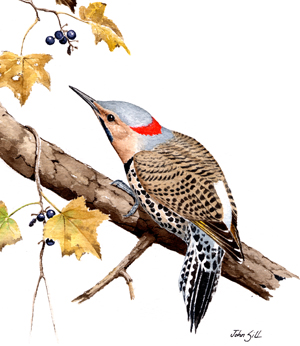Find a Bird
Northern Flicker
Colaptes auratus

Nearly ubiquitous and stable
Action/monitoring needed
“Yet what is really extraordinary is that a woodpecker should have become migratory at all. Woodpecker-food is always present, to be had for the pecking.... It has grown soft, its beak has grown slender and down-bent, it is nearer in some ways to the Cuckoos or Creepers than to the sturdy hewers, its progenitors.” – Aaron Clark Bagg and Samuel Atkins Eliot, Jr., Birds of the Connecticut River Valley in Massachusetts
Northern Flickers in America are divided into two subspecies, Red-shafted Flickers in the West and Yellow-shafted Flickers in the East. The bright yellow underwings of our Massachusetts flickers, as well as their frequent drumming, earned them the nickname “yellowhammer.” These handsome birds eschew the traditional woodpecker black and white plumage palette for one of brown, gray, red, and gold. Vocal and conspicuous, flickers may be the most obvious woodpeckers in the state of Massachusetts. While still widespread and commonly encountered, flickers are unfortunately showing a clear negative trend in abundance.
Historic Status
As he was compiling his three-volume Birds of Massachusetts and Other New England States for publication in the 1920s, Edward Howe Forbush was also tallying the colloquial names used throughout the United States of the species described in the book. “It is said it is known in various parts of the country by fully 125 common names,” he wrote of the species we now know as the Northern Flicker (Forbush 1927). Known to early ornithologists as the Golden-winged Woodpecker, the Flicker was somewhat persecuted by overzealous farmers who tabbed it as a fruit stealer in the nineteenth century, “but most unwisely,” wrote William Peabody in 1839, “for all the woodpeckers are very efficient aids to the horticulturist.” Throughout the nineteenth and twentieth centuries, ornithologists described the Northern Flicker as a common breeder across Massachusetts.
Atlas 1 Distribution
Few were the places in Massachusetts where the sharp cries and resonant drumming of the Northern Flicker could not be heard during the first Atlas. Block occupancy was essentially complete from our western border until the Berkshire Transition region, where flickers were still found in over three quarters of all blocks. This species was also truly ubiquitous in the Connecticut River Valley, which is not surprising since they spend much of their time foraging for ants on open ground. In the Boston Basin, they were missing only from the most heavily urbanized areas. They were also well represented from the Bristol/Narragansett Lowlands all the way out to Nantucket.
Atlas 2 Distribution and Change
The distribution of Northern Flickers in Massachusetts changed relatively little during the inter-Atlas period. A small decline in the nearly completely occupied western regions was noted. Flickers were stable or else showed modestly increasing numbers across much of central and eastern Massachusetts, apparently taking advantage of the matrix of maturing forest and open areas that they prefer for foraging. The Bristol/Narragansett Lowlands, however, reported a net loss of flickers in half a dozen blocks. Whether this is a reflection of a genuine trend or an anomaly of survey effort in that region is difficult to determine with certainty but like the far west may herald the beginning of steeper declines.
Atlas 1 Map
_BBA1.jpg)
Atlas 2 Map
BBA2.jpg)
Atlas Change Map
_Change.jpg)
Ecoregion Data
Atlas 1 | Atlas 2 | Change | ||||||
Ecoregion | # Blocks | % Blocks | % of Range | # Blocks | % Blocks | % of Range | Change in # Blocks | Change in % Blocks |
Taconic Mountains | 15 | 93.8 | 1.7 | 19 | 76.0 | 2.0 | -1 | -6.7 |
Marble Valleys/Housatonic Valley | 39 | 100.0 | 4.5 | 37 | 94.9 | 3.9 | -2 | -5.1 |
Berkshire Highlands | 55 | 100.0 | 6.4 | 52 | 94.5 | 5.5 | -3 | -5.7 |
Lower Berkshire Hills | 28 | 100.0 | 3.2 | 27 | 87.1 | 2.9 | -2 | -7.4 |
Vermont Piedmont | 15 | 88.2 | 1.7 | 17 | 100.0 | 1.8 | 0 | 0.0 |
Berkshire Transition | 31 | 81.6 | 3.6 | 37 | 92.5 | 3.9 | 3 | 9.7 |
Connecticut River Valley | 56 | 100.0 | 6.5 | 63 | 96.9 | 6.7 | 0 | 0.0 |
Worcester Plateau | 62 | 79.5 | 7.2 | 84 | 95.5 | 8.9 | 3 | 6.3 |
Lower Worcester Plateau | 65 | 87.8 | 7.5 | 77 | 96.3 | 8.1 | 1 | 1.9 |
S. New England Coastal Plains and Hills | 248 | 91.9 | 28.6 | 274 | 96.8 | 29.0 | 3 | 1.3 |
Boston Basin | 47 | 83.9 | 5.4 | 53 | 94.6 | 5.6 | 5 | 9.1 |
Bristol and Narragansett Lowlands | 99 | 93.4 | 11.4 | 94 | 82.5 | 9.9 | -6 | -5.9 |
Cape Cod and Islands | 106 | 77.9 | 12.2 | 112 | 77.8 | 11.8 | 2 | 1.7 |
Statewide Total | 866 | 89.4 | 100.0 | 946 | 91.2 | 100.0 | 3 | 0.4 |
Notes
Although the Atlas trends seem stable or modestly increasing, the Breeding Bird Survey sends a clear message regarding the Northern Flicker. The Breeding Bird Survey shows significant declines in the Northern Flicker’s abundance for Massachusetts, the New England/Mid-Atlantic Region, and the Eastern US overall. Despite the fact that they remain as widespread as ever, Northern Flickers are less numerous, and fall into our “whispering bird” category – those with a demonstrated stable or increasing footprint, but also a demonstrated decline in abundance.



